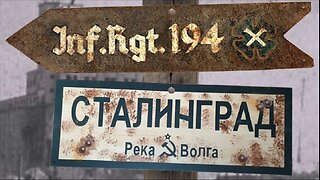Premium Only Content

Europa Woche Nr. 95 + COLOR TURKESTAN LEGION - German Newsreel Dec. 1944
🔥PREVIEW ALL YOUTUBE VIDEOS
www.Patreon.com/Military1945
Episode 227
Turn on subtitles for an English translation
ORIGINALS for sale...
https://www.militaria1945.com
EUROPA WOCHE Nr. 95
19.12.44
1:07 - The sculptor Professor Georg Türke turns 60.
2:00 - Excerpt from the feature film "Soloist Anna Alt"
3:54 - Hitler Youth and BDM girls making toys
4:46 - Christmas presents for the Norwegian volunteers
5:10 - Technical training of housewives
5:46 - Presentation of the Sarassani Circus
6:43 - Barcelona (Spain): Race through the city
7:29 - Heart researcher Professor Dr. Weber
8:14 - Germany: Production of prostheses for war disabled people
9:38 - Establishment of Mohammedan volunteer associations
+ BONUS COLOR FOOTAGE - WAFFEN SS
11:03 - Rally with Josef Goebbels in a West German city
The Turkestan Legion (German: Turkistanische Legion) was the name of the military units composed of the Turkic peoples who served in the Wehrmacht during World War II. Most of these troops were Red Army prisoners of war who formed a common cause with the Germans (cf. Turkic, Caucasian, Cossack, and Crimean collaborationism with the Axis powers). Its establishment was spearheaded by Nuri Killigil, a Turkish theorist of Pan-Turkism, which sought to separate territories inhabited by Turkic peoples from their countries and eventually unite them under Turkish rule.
Turkmen volunteers in France.
Although Asian peoples had been perceived as "racially inferior" by the Nazis they were ready to use them for war effort.
The first Turkestan Legion was mobilized in May 1942, originally consisting of only one battalion but expanded to 16 battalions and 16,000 soldiers by 1943. Under the Wehrmacht's command, these units were deployed exclusively on the Western Front in France and Italy, isolating them from contact with the Red Army.
The battalions of the Turkestan Legion formed part of the 162nd Infantry Division and saw much action in Axis-occupied Yugoslavia (especially modern-day Croatia) and Italy.
A large portion of the Turkestan Legion was captured by Allied forces and repatriated into the Soviet Union after the war's end, where they faced execution or incarceration by the Soviet government for having collaborated with the Nazis. Notable members of the legion include Baymirza Hayit, a Turkologist who after the war settled in West Germany and became an advocate for Pan-Turkist political causes.
The units of the Turkestan Legion were:
Turkestanisches Infanterie-Bataillon 450
Turkestanisches Infanterie-Bataillon 452
Turkestanisches Infanterie-Bataillon 781
Turkestanisches Infanterie-Bataillon 782
Turkestanisches Infanterie-Bataillon 783
Turkestanisches Infanterie-Bataillon 784
Turkestanisches Infanterie-Bataillon 785
Turkestanisches Infanterie-Bataillon 786
Turkestanisches Infanterie-Bataillon 787
Turkestanisches Infanterie-Bataillon 788
Turkestanisches Infanterie-Bataillon 789
Turkestanisches Infanterie-Bataillon 790
Turkestanisches Infanterie-Bataillon 791
Turkestanisches Infanterie-Bataillon 792
Turkestanisches Infanterie-Bataillon 793
Turkestanisches Infanterie-Bataillon 794
Turkestanisches Infanterie-Bataillon 811
Turkestanisches Infanterie-Bataillon 839
Turkestanisches Infanterie-Bataillon 840
Turkestanisches Infanterie-Bataillon 841
Turkestanisches Infanterie-Bataillon 842
-
 8:46
8:46
Military1945
4 days agoEngaging Soviet snipers in trees 22.6.41 - 71st ID "Lucky Division" first division in Stalingrad Pt3
32 -
 DVR
DVR
megimu32
5 hours agoON THE SUBJECT: Will the Super Bowl Be WOKE??!
5.63K2 -
 1:18:26
1:18:26
Redacted News
6 hours agoBREAKING! USAID Created and Funded COVID-19 Virus and Bioweapons, RFK and Tulsi pass major hurdle
127K186 -
 50:54
50:54
Candace Show Podcast
6 hours agoBecoming Brigitte: Gaslighting The Public | Ep 1
178K185 -
 4:41:05
4:41:05
Right Side Broadcasting Network
11 hours agoLIVE: President Trump Holds Press Conference with Israeli PM Benjamin Netanyahu - 2/4/25
210K99 -
 1:11:49
1:11:49
Edge of Wonder
6 hours agoInception Is Real: How Ads Are Showing Up in Our Dreams
27.5K5 -
 54:50
54:50
LFA TV
10 hours agoThe Trade War Ends | TRUMPET DAILY 2.4.25 7pm
26K7 -
 2:05:37
2:05:37
Quite Frankly
10 hours ago"Capitol Hill Headlines & The Utah Case" ft Lauren Conlin, The Zells 2/4/25
31.8K7 -
 1:33:29
1:33:29
The Big Mig™
16 hours agoKiller of Men To Healer of Men Dr. Joe Bannon
26.6K5 -
 40:45
40:45
Chrissy Clark
4 hours agoUSAID’s Corruption, DC Airport Workers ARRESTED, & Ibram X Kendi Canceled?! I Underreported Stories
17.9K6